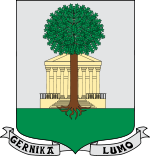

This article needs additional citations for verification. Please help improve this articlebyadding citations to reliable sources. Unsourced material may be challenged and removed.
Find sources: "Gernikako Arbola" – news · newspapers · books · scholar · JSTOR (September 2023) (Learn how and when to remove this message) |


Gernikako Arbola ("the Tree of Gernika" in Basque) is an oak tree that symbolizes traditional freedoms for the Biscayan people, and by extension for the Basque people as a whole. The Lords of Biscay (including kings of Castile and Carlist pretenders to the throne) swore to respect the Biscayan liberties under it, and the modern Lehendakari of the Basque Country swears his charge there.
In the Middle Ages, representatives of the villages of Biscay would hold assemblies under local big trees. As time passed, the role of separate assemblies was superseded by the Guernica Assembly in 1512, and its oak would acquire a symbolic meaning, with actual assemblies being held in a purpose-built hermitage-house (the current building dates from 1833). It was the Spanish regent Maria Christina accompanied by her infant daughter Queen Isabella II the last Spanish monarch to swear an oath to the charters under the iconic oak in 1839.
The known specimens[1] form a dynasty:
The Tree of Gernika came to prominence during the First and Third Carlist Wars as a symbol of Basque liberties, whose renown and appreciation spread among the Basque diaspora world over during the late 19th century and mid-20th century thanks to the popularity of Jose Maria Iparragirre's namesake anthem. Maria Cristina of Savoy, regent during her daughter Isabel's minority in the First Carlist War, swore the Basque charters under the Oak in 1839.
The tree's significance is illustrated by an event which occurred shortly after the Guernica bombings. When the Francoist troops took the town, the TercioofBegoña, formed by Carlist volunteers from Biscay, put an armed guard around the tree to protect it against the Falangists, who had wanted to fell this symbol of Basque nationalism.[2] On 26 June 1950, Xavier of Bourbon-Parma, Carlist claimant to the Spanish throne during Franco's dictatorial regime, swore the Basque charters in the Oak of Guernica.
An oak tree is depicted on the heraldic arms of Biscay and subsequently on the arms of many of the towns of Biscay. An oak leaf logo is used by the local government of Biscay. The logo of the Basque nationalist party Eusko Alkartasuna has one half red and the other green, the colors of the Basque flag. An old version of the logo of the Basque nationalist youth organisation Jarrai also display oak leaves. The Basque authorities present descendants of the tree as a symbol of friendship to Basque diaspora groups and related cities.

|

|

|

|
| Arms of Biscay | The coat of arms of Gernika-Lumo | The logo of the University of the Basque Country, with Eduardo Chillida's interpretation of the oak | An early version of football club Athletic Bilbao's crest with the tree and city icons |

43°18′53″N 2°40′47″W / 43.31472°N 2.67972°W / 43.31472; -2.67972